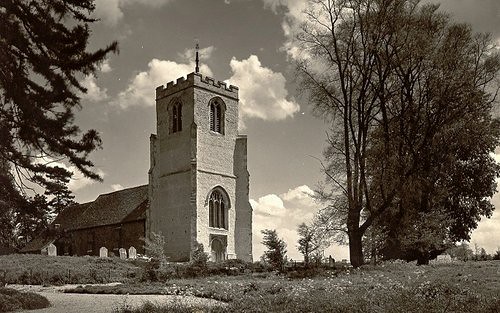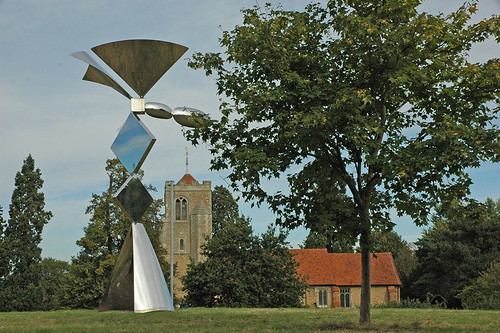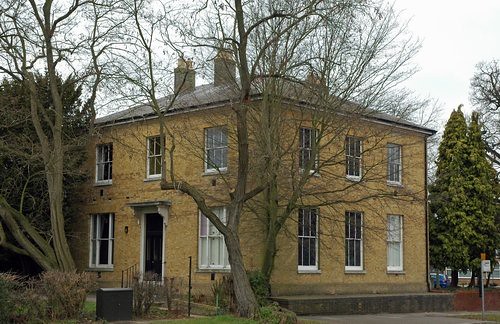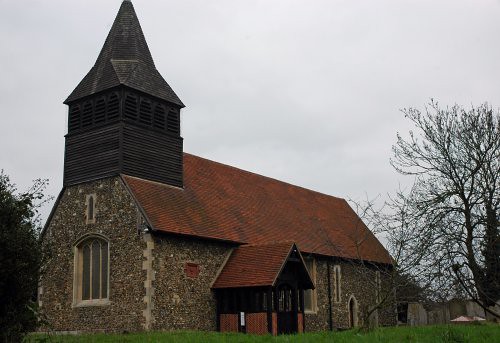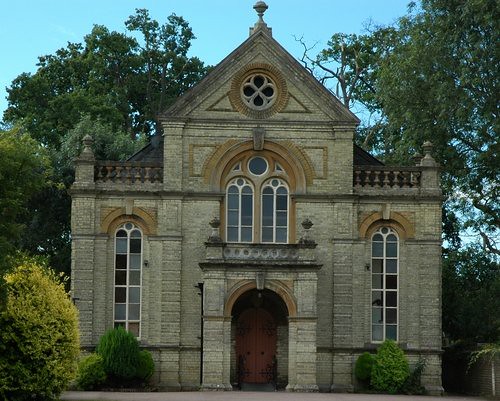Churches
Harlow Parish
Most mediaeval manors had their own church, and the landscape of the New Town is enriched by the presence of the surviving manorial churches. In 1947, six ecclesiastical parishes came within the boundaries of the town: 2 in Harlow and one each in Latton, Netteswell, Great Parndon and Little Parndon.
St. Mary and St. Hugh in Churchgate Street, dedicated as early as 1219, was Harlow’s church although, by the mid-12th century the advowson belonged to the Abbey of Bury St. Edmonds. The nave dates from the 12th century, the transepts and the round-headed window in the north-west corner of the nave from the 13th. A second dedication, to St. Hugh, Bishop of Lincoln, was added in the 15th century. The church was extensively rebuilt after a serious fire in 1708 which destroyed the steeple and melted the bells. It was then subjected to a major 'Victorianization' between 1877 and 1880, with half the cost born by John Perry-Watlington of Moor Hall, one of the town's major 19th century benefactors.
Harlow’s second church was built by subscription in 1839. The founders and parishioners of St. John the Baptist, located at the north end of St. John's Walk, off Market Street, supported the Oxford Movement. They objected to what they considered the rather 'low' traditions of St. Mary's. The Latin liturgy and incense in St. John’s followed High Church traditions. A new parish, which included most of the town, was created in 1857 and the advowson assigned to J.W. Perry-Watlington. However the two benefices were reunited in 1923, and St. John's declared redundant in 1979. The disused church was converted to the Harlow Arts and Recreation Centre in 1985.
Latton Parish
Latton, to the west of Harlow, was served by St. Mary the Virgin, also referred to as St. Mary-at-Latton. The present building occupies the site of a Saxon church which was demolished after the Conquest by the new owners. The Domesday Book records that the church was served by two priests, one appointed by site of Mark Hall, but now sits in a splendid location in the middle of the park created when the course of the Latton Road was moved westwards in 1785.
Remnants of the Norman church, built in 1087, remain: a small window in the south wall of the nave, and the arch of the original south doorway. Both are turned in Roman brick. The tower was rebuilt in the late 16th century, and incorporates more Roman brick, as does the south-east corner of the chancel. New stained glass windows were inserted during this rebuilding. One of the new windows cut off part of another Norman doorway on the south wall - this one had originally led into a small vestry. The porch was added by the Altham family in 1562.
In 1886, in order to marry his beloved Spanish fiance Maria Victorina Ysasi, Newman Gilbey converted to Roman Catholicism. Deprived of support from the lord of the manor the church fell into disrepair. However, eight members of the Gilbey family, including both Newman and Victorina, are buried in the church graveyard and Simon Gilbey, who died in March, 2009, asked that his name be added to one of the stones. Two of the family's servants, Mary Ryan and Antonia Ruiz, are buried here as well. Antonia's inscription, dated 1959, reads: 'Greatly loved for over 60 years in the service of Newman Gilbey and Maria Victorina.'
Between 1924 and 1941 only two people regularly attended the annual Vestry meeting: the Vicar and the Mark Hall gardener. Some of the stained glass in the southern windows was lost in 1945 when a V-1 rocket bomb exploded just south of the church, approximately where the sculpture 'Solo Flight' is located, south of Second Avenue. The church was repaired and re-consecrated in 1950 and then completely restored after a serious fire in 1964.
A new vicarage was built by Joseph Arkwright ca. 1820. Now called Moot Hall, it was converted into a community centre during construction of the New Town and now forms part of the complex centred on The Stow shopping centre.
The impressive remains of Latton Priory can still be seen amongst the buildings of Latton Priory Farm which are just outside Harlow, in an area controlled by the Epping Forest District Council. Eutropius de Merk of Mark Hall established this Augustinian priory in 1230. It was always a poor house, and struggled to maintain even the small complement of a prior and four canons. The lands were bought by Sir James Altham in 1562 and the building converted to a barn. However, the four arches of the crossing survive, as do portions of the transepts and a short section of the nave. The remains can be accessed by means of a public footpath running south from Latton Common Road.
The 17th century farm, and the remains of the Grade 1 listed priory, will presumably continue to exist in the future but in an entirely different spatial context. The East of England Plan requires the construction of tens of thousands of new houses in and around Harlow. In 2013 it was announced that plans were being drawn up for the Latton Priory Estate, described as a 'sustainable urban extension to the south of Harlow' for first-time buyers and the elderly. The proposal calls for up to 2,500 housing units, built over a 20-year period, as well as community facilities and employment space, set within woodland, parks and green space'. Six years later the plans have not been approved by the District Council. (The proposed development is described at www.lattonpriory.co.uk).
Netteswell Parish
The nave and chancel of St. Andrews were built in the Early English style in the 13th century but there has been a church on this site for far longer - perhaps as early as the 8th century. The first written record of a church at Netteswell is in a charter of Henry II, dated 1177. The wooden bell turret was added ca. 1400, and two of the three bells date from this period. Two 13th century lancet windows survive, one in each of the north and south nave walls. The southern window contains red and blue plumes which are said to be the device of Thomas of Woodstock, Duke of Gloucester - Lord of the Harlow Hundred - who was put to death by Richard II. The church was ' thoroughly restored', as they say, in 1875. The church was granted to Waltham Abbey in 1177. The adjoining six-bay tithe barn, referred to now as the Monk’s Barn, dating from ca. 1440 was used to store grain before it was sent on to the Abbey. Netteswell Pond, north of the church and barn, was one of the Abbey's fishponds.
The Monks’ Barn was formerly used as an engineering workshop and then a riding school. It suffered serious fire damage on 26 June 1970, but was carefully restored so that the original, fire-blackened, timbers can easily be differentiated from the modern replacements which faithfully reproduce the original unique joint work.
The manor and its church were sold to the Arkwrights in 1903 and then bought by the Harlow Development Corporation in 1947. The church was declared redundant in 1978 and, along with the Monks’ Barn and the adjoining 16th century Day Barn were converted into the Harlow Study Centre.
Parndon Parish
This parish was sub-divided in the 13th century, and therefore has two churches. The original church of St. Mary the Virgin, Great Parndon standing in the shadow of Katherines manor house, was built in the early 13th century. It was thoroughly restored in the 15th century; further additions (the south transept) were made in the 16th century, and the north transept added in 1913. The tower was restored in 1895 and again in 1969. It contains three bells, two cast in 1613 and one in 1779. One of the oldest ones is original; the other two were re-cast in 1958. St. Mary, Little Parndon was first mentioned in taxation records for 1250 and the first recorded rectors was in 1272. The original building was demolished in 1868 and a new church paid for by Loftus Arkwright. A particularly interesting feature of the churchyard is the grave of Hester Woodley. The burial register describes her as 'a negro woman, housekeeper to Mr. Parson, buries 16 May, 1767'. She was a slave owned by Bridget Woodley, daughter of a prosperous West Indian sugar planter, who married Edward Parson. Two other slaves are buried in the churchyard, one in 1777 and the other in 1787.
Other Churches
Essex has a long history of Protestant non-conformity. It was said in 1778 that 'the chief part of the population is made up of Independents and Baptists' and in 1810 a third of Harlow's population belonged to various other religions. Baptists were the most prevalent. They were one of the break-away groups which enjoyed a degree of religious tolerance under Charles II, and worshipped in the manor house at Campions as early as 1662. Two chapels were later built: one in Potter Street in 1756 and one in Fore Street in 1764 The Fore Street chapel was enlarged in 1810 and then replaced by the existing Italiante-stype chapel in 1865, when the congregation numbered 600.
Catholicism appears to have died out in the 18th century, and no adherents were recorded in the Session Rolls. However, when the Gilbeys moved to Mark Hall in 1894 they provided a centre for Roman Catholic worship in buildings of their estate. In 1950 Mr. and Mrs. Newman Gilbey made available a plot of land at Mulberry Green for the building of Our Lady of the Assumption - the first Catholic church built in Harlow since the Reformation.
A small Wesleyan Methodist chapel was built in 1886 in High Street, near Mulberry Green. It was apparently intended to be the Sunday School of a larger chapel that was never built. The building was converted to flats in 2004.

